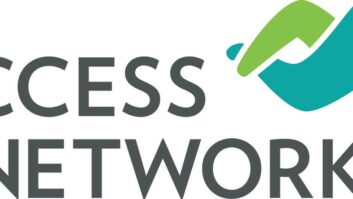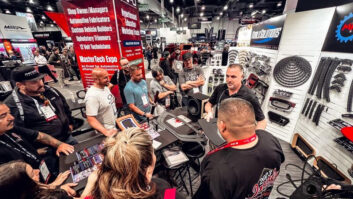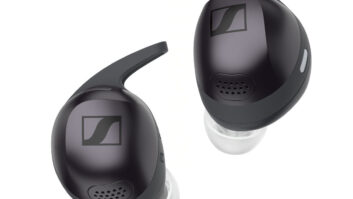Not only did portable computing devices and wireless phones converge at Wireless 2002, but wireless 802.11b local area networks (LANs) began to converge with wireless wide-area networks (WANs).
- Verizon, Sprint PCS and VoiceStream outlined plans to launch the industry’s first Pocket PC During the show:
2002-based PDA-phones. - Sprint announced plans to offer Handspring’s first CDMA-network Treo PDA-phone.
- Cingular said it would offer the industry’s first smartphone based on Microsoft’s Stinger OS.
- Multiple handset suppliers unveiled their first phones with j2ME or BREW technology to download small computing applications over the air.
Meantime, VoiceStream CEO John Stanton outlined intentions to offer wireless handoffs between VoiceStream’s EDGE and GPRS WANs and its 802.11b networks, which operate in 650 public “hot spots” such as airports and hotels.
Also underscoring the LAN/ WAN convergence:
- Nokia and GTran announced plans for hybrid PC Cards incorporating 802.11b and wireless WAN radio modems.
- Wireless application services provider (WASP) GoAmerica announced second-half plans to sell access to existing 802.11b networks in public hot spots. The company currently sells wireless e-mail and Internet microbrowser service over existing wireless WANs to handheld-device users.
Suppliers and carriers also outlined timetables for introducing the next generation of high-speed data technologies: EDGE and CDMA 1x EV-DO (see story on page 8).
PDAs: Among PDA-phone developments, Verizon announced plans to become the first carrier to offer a Pocket PC 2002 PDA-phone in the second quarter. The device, Audiovox’s Thera, operates on CDMA 2G and 1x networks and will be available through the carrier’s direct and indirect channels at around $800. The device is available to Verizon exclusively through July 1.
In other developments:
- Sprint PCS said its mid-year nationwide CDMA 1x launch will feature multiple new 1x phones, including Audiovox’s Thera PDA-phone. Sprint also said it will offer a CDMA 1x version of the Handspring Treo PDA-phone, either simultaneously with the Thera launch or soon after. Treo is currently available for GSM/GPRS networks.
- VoiceStream said it will offer a PocketPC 2002 PDA-phone for its GSM/GPRS network sometime in the summer. Unlike the Thera, this model will add Microsoft Pocket PC Phone Edition software, said Microsoft wireless marketing director Scott Gode. The software lets users initiate a voice call, SMS message, or e-mail from Outlook’s contact list. The software also features tighter integration with other Microsoft applications. For example, when a call comes in, music playing through Windows Media Audio software will automatically pause. The phone will be available to consumers sometime in the summer, Gode said.
- Cingular announced an exclusive agreement to offer Sendo’s long-awaited GSM/GPRS smartphone, based on Microsoft’s Stinger OS, in three to four months. Pricing wasn’t available. Cingular also said it will offer the Handspring Treo PDA phone in the next few months, but it didn’t say whether it would offer the keyboard-equipped version, touchscreen version, or both. The device has been available only through Handspring’s Web site, with activation on either the Cingular or VoiceStream networks.
Network convergence: In LAN/WAN convergence developments, VoiceStream’s Stanton didn’t say when he would offer handoffs from the carrier’s 11Mbps 802.11b networks to its EDGE and GPRS networks, but he called 802.11b “an integral part of our network.” He likened 11Mbps 802.11b networks to “3G on training wheels,” whetting consumer’s appetites for future high-speed 3G WANs, such as 384kbps EDGE and W-CDMA, which offers 2Mbps in stationary mode and 384kbps in mobile mode.
During his keynote presentation, Stanton said he envisions 802.11b service for stationary use in hot spots such as campuses and coffee shops, EDGE for wider coverage in “core area networks” to offer mobile speeds up to 384kbps, and GPRS as a WAN offering ubiquitous coberage typically at 40kbps. VoiceStream will deploy EDGE next year, and by the end of this year, GPRS in markets with a population of 200 million people.
Sprint PCS also acknowledged an interest in 802.11b. Sprint PCS president Charles Levine said he expects a “symbiotic relationship” with companies such as Boingo, which sells access to independently owned 802.11b networks. That relationship could include “integrated service plans,” he said.
Nokia and GTran unveiled the first PC Card radiomodems that operate on wireless-phone networks and 802.11b LANs. The cards, however, don’t hand off an Internet connection from one network to the other.
Nokia demonstrated a model combining 802.11b, packet-data GPRS, and circuit-switched GSM technology. It operates in 850/1900MHz spectrum, doesn’t offer voice service, and is due in the third quarter at around $300.
GTran demonstrated a card operating on 802.11b and 800/1900MHz CDMA 1x networks. Dialing software and a microphone jack permits voice calling through a hands-free headset. The device will be available sometime this year.











